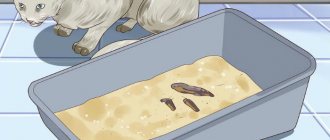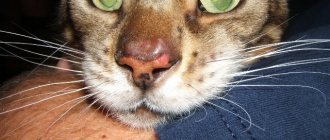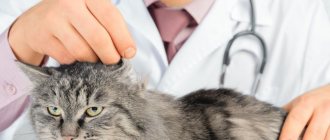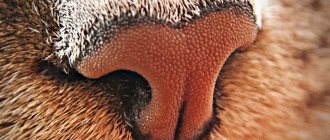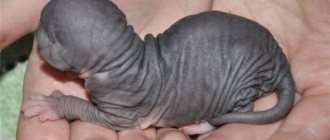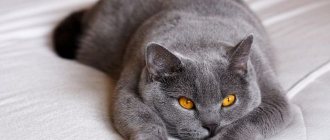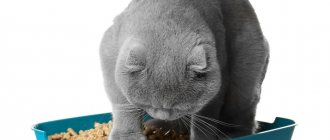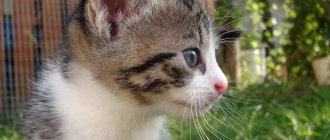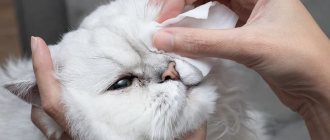Coughing in a cat is a fairly common occurrence, indicating irritation of the center in the brain. There may be several reasons why a pet may cough, as if it is choking. It is unacceptable to leave such a symptom unattended, since the provoking factor can be both a cold infection and serious forms of bronchial asthma.
By carefully observing the animal and changes in health and condition, the owner can independently determine some of the reasons that provoked the cough.
By its nature, cough is not a disease. This is a kind of signal from the body, a specific reflex that occurs in the body when certain parts of the respiratory tract are irritated.
The cause may be household dust, chemicals (various acid-containing substances and alkalis), pathogenic bacterial microorganisms, viruses and fungal spores. Due to the appearance of a cough, the body tries to independently eliminate the irritating factor - mucus, exudate arising from inflammatory processes, foreign bodies.
It is necessary to understand what can trigger a cough in a cat in order to promptly contact a veterinarian for advice and detailed diagnosis. Only in a veterinary clinic will a cat be given adequate treatment.
What is a cough
A cough in a cat, like in a person, is a protective reaction of the body when a sharp expulsion of air occurs through the mouth - a loud exhalation. This is necessary to remove foreign objects from the respiratory tract: particles of substances, dust, as well as bacteria, viruses, fungi, mucus that accumulates during inflammation.
In cats, cough receptors are located in the trachea, larynx, and bronchi. Therefore, cough in animals occurs due to pathologies in these organs. However, these same cough receptors also respond to external irritation from neighboring organs and tissues. Hence, the number of reasons that can cause coughing and wheezing in a cat increases sharply.
Sometimes the cough is accompanied by vomiting. The acidic contents of the stomach enter the larynx, irritate it and the coughing attack intensifies. Therefore, the owner, seeing a coughing pet, thinks that he is vomiting.
It is important for the owner to be able to distinguish between states when the animal wants to vomit or regurgitate, and when it coughs.
To do this, you need to understand how cats cough:
- The back arches, and the abdominal wall is pressed inward, pulling toward the spine.
- The cat, pressed to the floor, lowers its head and stretches its neck forward.
- The mouth opens slightly and a characteristic coughing sound is heard.
Take care of the sick
What to do if your cat has a stuffy nose? First of all, you must improve the living conditions of your pet. Give large quantities of warm water only, and it is also better to feed warm food during the period of illness. Watch carefully for drafts. If your cat has a cold, you can put a heating pad in her house.
Remove discharge from the nose and crust with a damp cotton swab or disk. If the cat does not have a fever, warm its nose with a bag of hot sand or coarse salt. Brew chamomile and wipe your watery eyes with this infusion. Chamomile will relieve inflammation.
If your cat is sneezing and has a stuffy nose, try rinsing her nasal passages. Add two teaspoons of sea salt to a glass of boiled water. If possible, you can dilute beet juice with water in a ratio of one to three. You can instill it into your nose with a pipette or syringe without a needle. Before the procedure, try the prepared solution on yourself, because cats have more delicate mucous membranes than people.
Buy food with a stronger smell. If a cat has a stuffy nose, she doesn't smell well. When she smells such food, she will happily eat.
In winter, when the heating is on, it is better to cover the radiators with wet towels: dry air is more difficult to breathe.
Misconception
If your cat does not leave the apartment and does not come into contact with other animals, this does not mean that she cannot catch an infection or virus. You yourself can carry germs and parasites on your clothes or shoes.
Features of cat cough
To establish an accurate diagnosis, the doctor will definitely interview the owner about the nature of the cough and its characteristics.
Characteristics of cat cough:
| Occurrence frequency | Rare Frequent Constant |
| Force | Mild coughing Harrowing Exhausting to the point of vomiting |
| Character | Paroxysmal wheezing With wheezing |
| Duration | Acute Protracted Chronic (lasting more than 2 weeks) |
| Type of manifestation | Dry or unproductive without phlegm. Wet or productive with sputum production. This is noticeable because the cat swallows something after clearing its throat. It is rare for sputum to fly out of a cat's mouth when coughing. |
| Appearance time | Morning Afternoon Evening |
When observing your pet, you should try to determine the type of cough based on these parameters, so that you can then tell the veterinarian. It’s better to make a video so that the doctor himself can conduct the assessment.
Signs and types of wheezing
Wheezing is not just one sound. This is a whole combination of noise, each option corresponds to a specific group of pathologies.
Wheezing is usually classified into:
- wet;
- dry;
- crepitant;
- whistling.
Wet wheezing sounds appear due to the accumulation of mucus (phlegm) in the bronchi of the cat. Sputum is produced in large quantities as a result of inflammatory processes affecting the bronchial tree. The air inhaled by the animal passes through the mucus, bubbles form, which then burst. This is what causes wheezing. Moist rales are divided into small-, medium-, and large-bubble.
The first accompany the collapse of small bubbles formed by sputum. May occur with pulmonary infarction or bronchopneumonia. The latter resemble the sound of air blown through a straw. They occur when there is hypersecretion of mucus as a result of bronchitis, fibrotic changes in the lungs or pneumosclerosis.
The latter type of wheezing is clearly audible even without a stethoscope and occurs due to the accumulation of exudate in the lungs with a weak cough reflex or pulmonary edema.
Dry noises are divided into whistling and buzzing. They arise due to narrowing of the lumen of the bronchi as a result of obstruction, mechanical compression by the tumor and the development of an allergic reaction. The air swirls and has difficulty squeezing through the narrow gap, which creates noise. When air passes through the unevenly narrowed bronchi, the sound becomes whistling. If there is viscous mucus in the bronchi, the mucous membranes block the path of air. And the breath passes with a slight buzzing sound, as if the air is squeezing through a narrow and half-covered hole.
What makes a cat cough
Cough in cats can be divided into 2 types:
- Reflex when it is a reaction to stimuli.
- Symptomatic, when the act of coughing is a symptom of some disease, and not a separate disease.
A cough spasm occurs if an animal has inhaled caustic gases, smoke, or odorous aerosols. The most common cause of a reflex cough is the entry of foreign particles into the larynx or trachea. And also if foreign objects are in the esophagus or pharynx and put pressure on the trachea and larynx. The cat coughs and wheezes, stretching out and pressing herself to the floor, as if she had choked. She will cough until the foreign object is coughed up or until it is removed. If foreign objects are in other areas, then the cough cannot be caused.
The causes of symptomatic cough are more varied. Doctors name more than 50 diseases, one of the symptoms of which is cough.
Breathing wheezing in a cat
A cat's wheezing breathing may indicate that the animal has a disease, and it urgently needs to be seen by a doctor. It would be in vain to assume that wheezing when breathing in a cat is the norm for a common cold and that the cat will soon heal on its own.
Breathing disturbances (and wheezing is always a disturbance) never go away on their own in cats and without timely treatment they provoke the development of more severe pathologies that entail serious consequences, even the death of the animal.
Wheezing in itself is not a disease. They always represent a concomitant symptom of any disease. There are crepitating rales, blistering and dry. All of them are characteristic of certain diseases.
So, for example, crepitating wheezing (in other words, crackling) appears with pneumonia, atelectasis; vesicular (wet) are observed in patients with bronchitis and pulmonary edema; dry wheezing is characteristic of diseases of bronchospasm and bronchitis. You can also distinguish a separate type of wheezing - the so-called whistling. It is usually distinguished by paralysis of the glottis and foreign particles entering the trachea.
Symptoms depending on the type of cough
If your cat starts coughing, it is important to take a closer look at how he does it and what other symptoms are present. This is necessary to later describe the condition to the veterinarian.
Foreign body
One of the reasons why a cat coughs as if choking is when some object gets into the airways. The cough then appears suddenly, suffocating, lasts constantly, always with shortness of breath. If a foreign body ends up in the pharynx or esophagus, the cat coughs regularly with attacks. At the same time, it is painful for the animal to swallow, drooling, and nausea.
Respiratory cough
Respiratory tract infections (rhinotracheitis, calcivirosis, mycoplasmosis, bordetellosis) are a common reason why a cat coughs.
Infections generally manifest themselves as cold symptoms:
- cough is acute, often dry;
- sneezing (sometimes a wet cough that sounds like a sneeze);
- lacrimation;
- purulent discharge from the nose;
- conjunctivitis;
- runny nose;
- increased body temperature;
- ulcers may appear in the mouth.
In cats, especially kittens under one year of age, rhinotracheitis is one of the main causes of cough.
The next most common cause is bronchitis.
With bronchitis, as well as pneumonia, from the first days of illness the cat is weak and eats poorly. A cough appears on day 2-3. At first it is dry and deep, but over time it becomes moist and dull. It can be both rare and paroxysmal. Snot appears. At first transparent, then white or greenish.
Bronchitis and pneumonia are also accompanied by other symptoms:
- Increased temperature (hyperthermia), in severe cases, on the contrary, the temperature is reduced.
- Complete lack of appetite.
- Difficulty breathing, both when inhaling and exhaling.
- Oppression.
In chronic bronchitis, a severe cough appears when the animal gets up from a lying position.
It is not uncommon for a cat with chronic bronchitis to develop pneumofibrosis, a disease in which scarring forms on the lungs and makes it difficult for the animal to breathe. The cough is dry. It may manifest itself rarely or regularly, but with a single cough.
Laryngitis and tonsillitis
Laryngitis is an inflammation of the laryngeal mucosa, which can be caused by rhinotracheitis, calicivirus, but also be a consequence of injury, laryngeal tumor, or paralysis. The disease is accompanied by a cough, first dry, then with sputum discharge.
In acute laryngitis, a cat's cough is especially painful. The pet may shake its head, stretch its neck, moan, and make swallowing or chewing movements. The voice changes - it becomes hoarse, and the meow may be lost. Acute laryngitis lasts 1-1.5 weeks. If treated incorrectly, it can become chronic with regular attacks of exacerbation.
Tonsillitis is inflammation of the tonsils or tonsillitis. The disease in its acute form is manifested by drooling, lethargy, and fever. The cat has difficulty swallowing, so it refuses to eat or has difficulty eating and drinking. Meows hoarsely, abruptly, coughs.
Asthmatic cough
Feline asthma in its manifestations is similar to how a person is sick. Asthmatic syndrome is characterized by a prolonged cough with suffocation. During the rest period, coughing is rare, but coughing attacks occur suddenly. The cat is breathing heavily and wheezing is heard when breathing. During an asthma attack, the mouth is open, the tongue shows signs of cyanosis, the pupils are dilated, trembling, the animal seems to be suffocating. Over time, the pet becomes lethargic, apathetic, and is in a state of constant drowsiness.
Causes
It is very important to find out why your cat is sick, because the method of treatment and care depends on this.
- The most common cause is a cold. The site Ko6e4ka.ru reminds you that just because cats have thick and warm fur does not mean that they cannot become hypothermic. The cat could simply drink cold water or take a walk in a draft.
- Allergy. Your cat could walk along the windowsill and smell the blooming flowers, or flowers given for his birthday. This is enough to make you lose your sense of smell for a week. If your cat has an allergy, it is unlikely that he will feel very unwell, but his eyes may become watery.
- Smell of chemicals. Any means for washing dishes, floors, windows, or washing powder can provoke a runny nose attack. In such cases, the cat usually has a very stuffy nose and watery eyes. There is no need to treat such a runny nose; it is enough to ventilate the room. If the cat begins to choke, the nasal mucosa is swollen, or you see a burn on the nose, call a veterinarian immediately, it could be poisoning with toxic fumes!
- Something got in my nose. The cat could have inhaled a grain of sand or other small particle. It scratches the mucous membrane and causes swelling. Such particles come out on their own with a large amount of snot, but if the object was of significant size, it is worth showing the cat to a doctor.
- Neoplasms in the upper respiratory tract.
- Infectious diseases.
- Parasites.
If the cat's condition is normal, she does not lie down all the time, eats well, is cheerful and playful, then you can try to help her yourself. If the animal is very ill, then it is better not to risk it and show it to a specialist.
Treatment of cough at home
At home, the owner can help his pet only in two cases:
- it is possible to remove the foreign body;
- the cat inhaled gases or smoke.
In the latter case, the most important thing is to eliminate the effect of irritants and ensure a flow of fresh air. To do this, either take the pet outside or place it in a well-ventilated area.
If there are other accompanying symptoms, you cannot treat them at home or give your cat medications. Firstly, it can make the situation worse. Secondly, it will blur the overall picture and complicate the doctor’s task of making a diagnosis.
How can I help if my cat sniffles and sneezes?
Whatever the cause of congestion, we first need to help the animal restore normal breathing. To do this you should:
- rinse the nasal passages with saline (we discussed the rinsing technique in detail in the article “What to do at home if a cat sneezes?”) - this will help remove thick discharge and crusts, reduce the concentration of infectious particles, and slightly relieve swelling of the mucous membrane;
- for an anti-inflammatory effect, you can also use chamomile decoction after completely cleansing the nose, using the same technique;
- if rinsing does not give the desired result, and the cat is still sniffling and sneezing, it is necessary to instill any children's drops that relieve swelling by constricting the vessels of the mucous membrane (nazivin, otrivin, vibrocil, etc.).
Once the symptoms have subsided, the best solution is to take your pet to the doctor to determine the exact cause of the disease and finally cure the animal. You should not ignore veterinary help: simple nasal congestion in cats may be the first symptom of a dangerous disease.
What canned food tastes best for cats?
RESEARCH ATTENTION! You and your cat can take part in it! If you live in Moscow or the Moscow region and are ready to regularly observe how and how much your cat eats, and also remember to write it all down, you will receive FREE SET OF WET FOOD.
Project for 3–4 months. Organizer - Petkorm LLC.
Want to participate? Call!
How to tell if your cat is choking and not coughing
It is safe to think that the cat has choked if the following picture is observed:
- The cat does not take a characteristic pose (with bent legs, elongated neck).
- There is gagging and wheezing.
- The animal is trying to pull something out of its mouth with its paw. May roll around on the floor and show obvious anxiety.
- Drooling is flowing from the mouth because there is no way to swallow.
This behavior is usually preceded by eating or playing with small objects.
How to clean a cat's nose?
A cat's nose is a means of smell, like all living beings. And dirt accumulates in it, which prevents the pet from breathing. The cat begins to sniffle, breathing slows down and becomes heavy. If no other abnormalities are observed, it means that the animal either has a normal runny nose or an accumulation of dust and dirt in the nasal passage.
There is no need to regularly clean your nose. In most cases, all the dirt comes out on its own and does not require human intervention. Help is needed when a clogged nose causes obvious discomfort to the cat. How to clean a cat's nose? To do this you will need saline solution, a syringe and a cotton swab.
Instead of a solution, you can use special drops for animals. First, you need to draw a little solution into the syringe from which the needle is removed. Then, use a cotton swab to treat the area near the nose.
It is necessary to remove all accumulated dirt so that it does not get into the nasal passages again. After this, the cat needs to be clamped (you may need outside help) and half a milliliter of saline solution from a syringe is dripped into each nostril. The liquid will wash out the nose and the cat may start sneezing. This is normal and even good - sneezing helps release dirt.
You can clean your pet's nose yourself only if there is a guarantee of absence of diseases. If a cat’s nose is not breathing, this may indicate a cold or infectious disease. In many cases, the disease is accompanied by fever, loss of appetite and runny nose. The nose becomes dry and hot, and mucus may come out of it.
If such symptoms appear, you should contact your veterinarian. Any infectious disease can be easily cured at the initial stage. In the future, it becomes chronic and can lead to the death of the animal.
Even a common runny nose can become chronic, which will cause your pet a lot of trouble and discomfort. Of course, animals periodically experience nasal discharge, but this can last no more than three days. If the runny nose persists, it is better to show the animal to a specialist.
The appearance of crusts in the nose can also be a consequence of serious diseases. Don't worry if you only had to clean your cat's nose once. If hoarse breathing reappears, go straight to the hospital. If the life of your beloved pet is precious, then help must be provided in a timely manner.
Diagnostics
Before treating a cough, you need to establish the causes, of which there may be several dozen. After all, a cough is only a symptom. Finding out exactly what happened to your pet can take a long time.
The doctor's actions include the following measures:
- Owner survey.
- Examination of the patient, listening to wheezing, heart and lung murmurs.
- An x-ray is taken.
- A general blood test is prescribed.
- A bacterial culture is done to determine the causative agent of the infection and its resistance to antibiotics and antimicrobials.
- A biopsy is performed if cancer is suspected.
This is not a complete list of diagnostic methods. If the cause of the animal’s poor health is not determined, then bronchoscopy is done, a method that examines the inner surface of the trachea and bronchi. Very often, before treating a pet, consultations with veterinarians specializing in cardiology, oncology, and other areas are required.
Pulmonary causes of wheezing
Pulmonary causes can be associated with inflammatory processes in the bronchi and lungs of an allergic and non-allergic nature, and with respiratory tract injuries (foreign body entry, hematomas, pneumohydrothorax, diaphragmatic hernia).
Cats do not get the flu or ARVI. But they have their own viral infections (rhinotracheitis, calcivirosis), which can cause the animal to cough and wheeze.
Rhinotracheitis and calcivirosis
Both diseases are viral in nature and are quite dangerous for cats. Both are accompanied by damage to the mucous membranes of the respiratory tract and intestines. They occur with high fever, diarrhea (in severe cases with dehydration), cough and wheezing. With calcivirosis, the cat's visible mucous membranes and tongue are ulcerated. With rhinotracheitis, there is abundant mucopurulent discharge from the eyes and nose.
Pneumonia
This disease in cats can be bacterial, viral or fungal in nature. At first, a strong “barking” cough appears, as if scratching the airways, and the temperature rises. Then the cough becomes wet with wheezing of large or fine bubbles. The general condition of the animal is impaired.
Bronchial asthma
An animal with this pathology takes a characteristic position: presses against the floor, stretches its neck, makes wheezing sounds, and sometimes coughs. In severe cases, expiratory shortness of breath up to suffocation is observed. With asthma, owners often believe that their animal is choking, which is why it wheezes.
Helminthiasis
Wheezing, similar to symptoms of bronchial asthma, can be caused by the migration of parasites. The most common diseases found in cats are aleurostrongylosis (more common in America) and dirofilariasis.
Oncology
Tumors of the respiratory tract can be benign and malignant, primary and metastatic. Oncopathology of the respiratory system is less common in cats than in dogs. Older animals get sick more often. The development of a tumor in any part of the respiratory tract can cause breathing problems and wheezing. The most common signs of growth of a tumor in the larynx are impaired breathing, difficulty, hoarseness and changes in voice. The pet's voice becomes squeaky or hoarse. The disease is accompanied by shortness of breath and cough, sometimes mixed with blood.
Brachycephalic syndrome
The disease involves pathological growth of the tissues of the velum and narrowing of the nasal passages. The animal wheezes and wheezes heavily. He sleeps with his mouth open and snores. He eats normally. Remains active.
Laryngeal edema, laryngospasm
This condition can develop as a result of poisoning with household chemicals, allergies to inhaled dust, tobacco smoke, strong aromas, etc., an autoimmune reaction. Much less often, mechanical damage to a cat’s larynx leads to laryngospasm. At the same time, the animal’s body feels an acute lack of oxygen and stress hormones are released. The cat is frightened, wheezes and wheezes heavily, breathes with difficulty, whistling, and screams in a “bad” voice.
Pneumo- and hydrothorax
Develops as a result of rupture of the lungs by a tumor, open wound or closed injury. The pet's breathing is difficult, he sits with his mouth wide open, breathes with difficulty and hoarsely, and is very scared.
Inhalation of a foreign object
A foreign body can get stuck in the animal’s pharynx, trachea and bronchi. It may be small and move along the bronchial tree, causing bouts of repeated coughing and wheezing. Or large and block the airways partially (working as a valve) or completely. In this case, the animal coughs, wheezes heavily, rubs its neck on objects, and mucous-foamy sputum, sometimes mixed with blood, is released from the nose. The animal does not drink, does not eat and may suffocate.
Pulmonary edema
Pulmonary edema can be caused by a variety of diseases of internal organs, injuries and inflammation of the lungs, aspiration of vomit, water, and small objects. The cat takes a forced position, breathes hoarsely, with difficulty, pink foam comes out of its nose, and its sides swell.
Congenital pathologies
Narrowing of the nasal passages, an elongated soft palate, and polyps can cause breathing problems and hoarse sounds heard when the animal breathes, especially after exercise.
Tracheal collapse
At the initial stage, it does not cause any particular concern to the animal. Manifests itself in the form of a cough during a strong emotional outburst. Over time, the condition worsens, hoarse breathing appears, shortness of breath, and the cough intensifies. The animal may lose consciousness.
Treatment
The goal of any treatment procedure to combat cough is to eliminate the cause that caused it:
- For helminthic infestations, drugs that destroy worms are prescribed. Prevention – regular deworming.
- If cardiac pathologies are detected, the functioning of the heart and vascular system is stabilized. The cat is put on a special diet.
- To treat respiratory infections, antiviral agents and antibiotics are prescribed, depending on the specific disease.
- There is no way to completely cure asthma. Lifelong therapy is indicated for the animal. Corticosteroids are recommended to relieve swelling and inflammation, and bronchodilators are recommended to ease breathing.
- If the cause of cough spasms is trichobezoars, special pastes or a diet are prescribed that facilitate the removal of hair from the stomach naturally.
- When the injuries and scratches from the bones heal, the soreness and cough go away. Therefore, only nutritional recommendations are given. During the recovery period, the animal is switched to soft food.
First wince when breathing stops
In the most critical situation, when the cat has stopped breathing, it may be necessary to perform artificial respiration and chest compressions. The process is as follows:
- Lay the cat straight, fix its position so that the neck is in a straight line with the spine;
- The animal's mouth must be closed. If necessary, it must be freed from foreign objects, saliva, mucus;
- Exhale air into the animal’s nose through a cupped palm. The frequency of exhalations depends on the size of the cat. It is approximately 20 exhalations per minute. With slight expansion of the chest, the volume of air is considered sufficient;
- Kittens should be given artificial respiration especially carefully so as not to damage their small lungs with a large volume of air;
- In case of cardiac arrest, perform indirect cardiac massage. To do this, press the cat’s chest with your palm with your thumb on one side and the other four on the other. Rhythmically and sharply squeeze and relax your fingers five times in a row, then exhale into the animal’s nose. You should check for a heartbeat every two minutes.
It is necessary to pay attention to any manifestations of hoarse breathing in your pet. With this symptom there are almost always serious health problems present.


